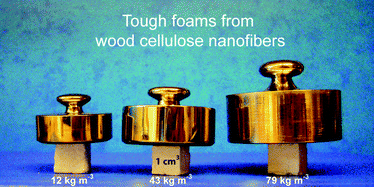Mechanical performance tailoring of tough ultra-high porosity foams prepared from cellulose I nanofiber suspensions
Abstract
Low-density structures of mechanical function in plants, arthropods and

* Corresponding authors
a
Department of Fiber and Polymer Technology, Royal Institute of Technology, Stockholm, Sweden
E-mail:
blund@kth.se
Fax: +46 8 207865
Tel: +46 8 7908118
b
School of Biotechnology, Royal Institute of Technology, Stockholm, Sweden
E-mail:
qi@kth.se
Fax: +46 8 55378468
Tel: +46 8 55378383
c Wallenberg Wood Science Center, Royal Institute of Technology, Stockholm, Sweden
Low-density structures of mechanical function in plants, arthropods and

 Please wait while we load your content...
Something went wrong. Try again?
Please wait while we load your content...
Something went wrong. Try again?
H. Sehaqui, M. Salajková, Q. Zhou and L. A. Berglund, Soft Matter, 2010, 6, 1824 DOI: 10.1039/B927505C
To request permission to reproduce material from this article, please go to the Copyright Clearance Center request page.
If you are an author contributing to an RSC publication, you do not need to request permission provided correct acknowledgement is given.
If you are the author of this article, you do not need to request permission to reproduce figures and diagrams provided correct acknowledgement is given. If you want to reproduce the whole article in a third-party publication (excluding your thesis/dissertation for which permission is not required) please go to the Copyright Clearance Center request page.
Read more about how to correctly acknowledge RSC content.
 Fetching data from CrossRef.
Fetching data from CrossRef.
This may take some time to load.
Loading related content
